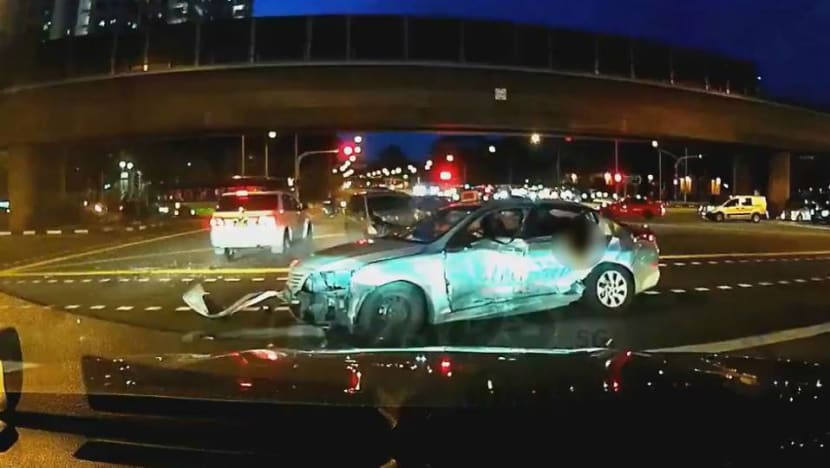Judge finds cabby 65% liable in car crash that killed NUS undergraduate, in civil suit by surviving passenger

Screengrab of a video of an accident that took place at the junction of Clementi Road and Commonwealth Avenue West on Apr 19, 2018. (Source: Roads.sg / Facebook)
SINGAPORE: A taxi driver behind the wheel in a collision that killed a National University of Singapore (NUS) undergraduate was accorded 65 per cent liability for his negligence in the case, a high court judge ruled in a civil suit on Friday (Oct 2).
The other driver, who was going straight and speeding before crashing into the cabby who made a discretionary right turn, was assigned 35 per cent liability.
Justice Aedit Abdullah ruled that the plaintiff, a surviving passenger who was accused by the defendants' lawyers of not wearing a seatbelt, bore no liability. Damages to be paid will be assessed at a later date.
Mr Ting Jun Heng, 24, sued 56-year-old taxi driver Yap Kok Hua and 23-year-old driver Ng Li Ning in a case that came to court in June, over a crash in April 2018. He was flung out of the cab and suffered multiple injuries.
Mr Ting, then a first year university student, was in Yap's cab with three friends Ms Kathy Ong, Mr Zon Lim and Mr Lim Jin Jie - on the way to NUS' Tembusu College on the night of Apr 19, two years ago.
At the cross junction of Commonwealth Avenue West and Clementi Road, Yap made a discretionary right turn when Ng's vehicle was approaching from the opposite direction at a high speed.
The crash threw Ms Ong partially out of the window and she died in hospital aged 19, while Mr Ting suffered injuries including traumatic brain injury.
He was initially in a vegetative state, but recovered and sustained fractured ribs, a kidney laceration and multiple pelvic bone fractures. He suffered medical complications, had his studies deferred and now walks with a slight limp.
Justice Aedit said that the greater degree of responsibility lay on Yap, the taxi driver, who was making a turn while Ng was going straight.
READ: Taxi driver jailed over crash that killed NUS undergrad Kathy Ong
Yap had been convicted of criminal charges over the case, sentenced to eight weeks' jail last year, and banned from driving for five years. Ng also faces a criminal charge, which is still pending in the State Courts.
It was incumbent on Yap to keep a proper lookout, said Justice Aedit. If there had been any doubt whether it was safe to proceed, he should have waited for oncoming traffic to clear.
The judge also found that Ng had been travelling between 74kmh and 87kmh, with an average speed of 82kmh. Ng did not dispute during the trial that he had been speeding.
Even if Ng had the right of way, it does not absolve him of the need to exercise due care, said Justice Aedit, saying that drivers travelling straight should not proceed as if other drivers ahead are incapable of coming into their paths.
While the defendants had argued that the plaintiff was not wearing a seatbelt at the time, the judge found that he did not bear any liability in the case.
Mr Ting had testified that it was his usual practice to wear a seatbelt, and the judge found no reason to find that he had not.
Even if Yap's statement of facts in his guilty plea stated that the passengers were not wearing seatbelts, this was of little effect against Mr Ting as he was not party to those criminal proceedings nor convicted of any offence, said the judge.
He gave all parties time to make submissions on costs, before any appeals are made. A pre-trial conference will subsequently be held in relation to the quantum of damages.
Ng will return to the State Courts on Oct 9 for a pre-trial conference for his criminal charge, and is accused of driving dangerously above the speed limit.














